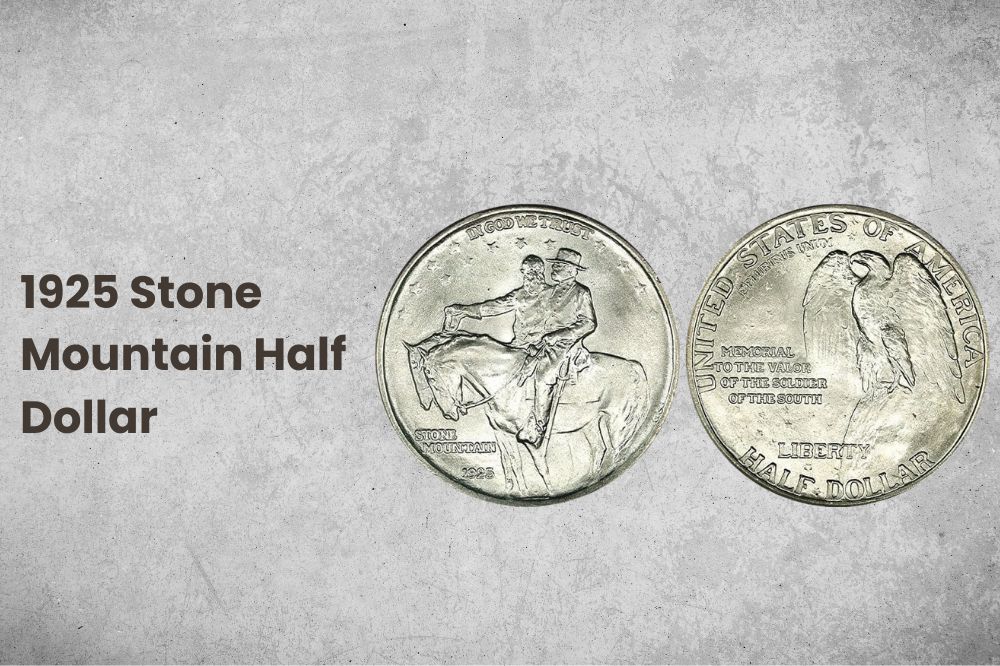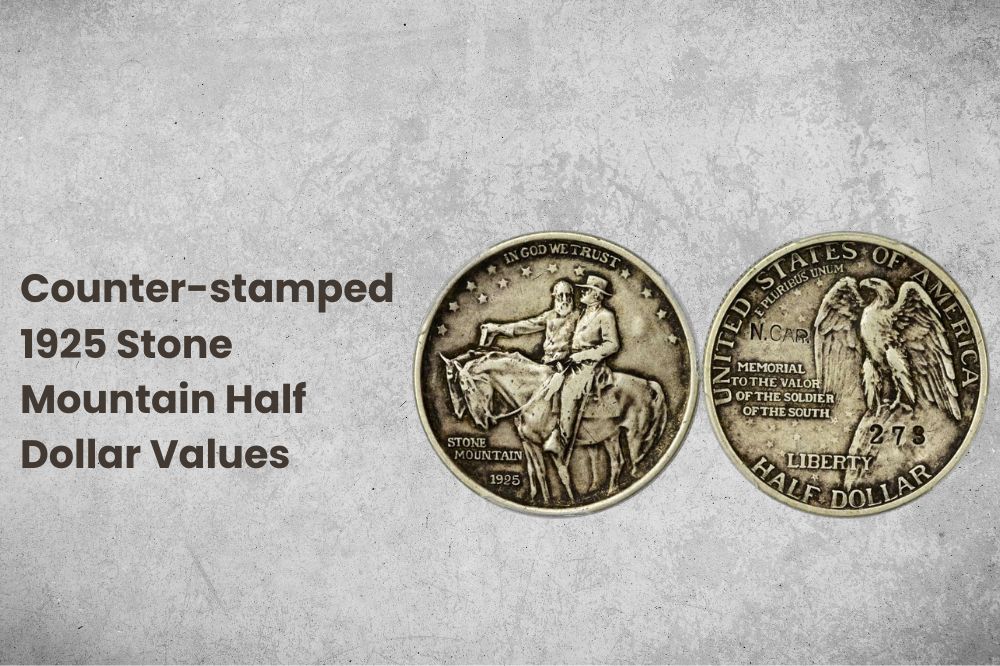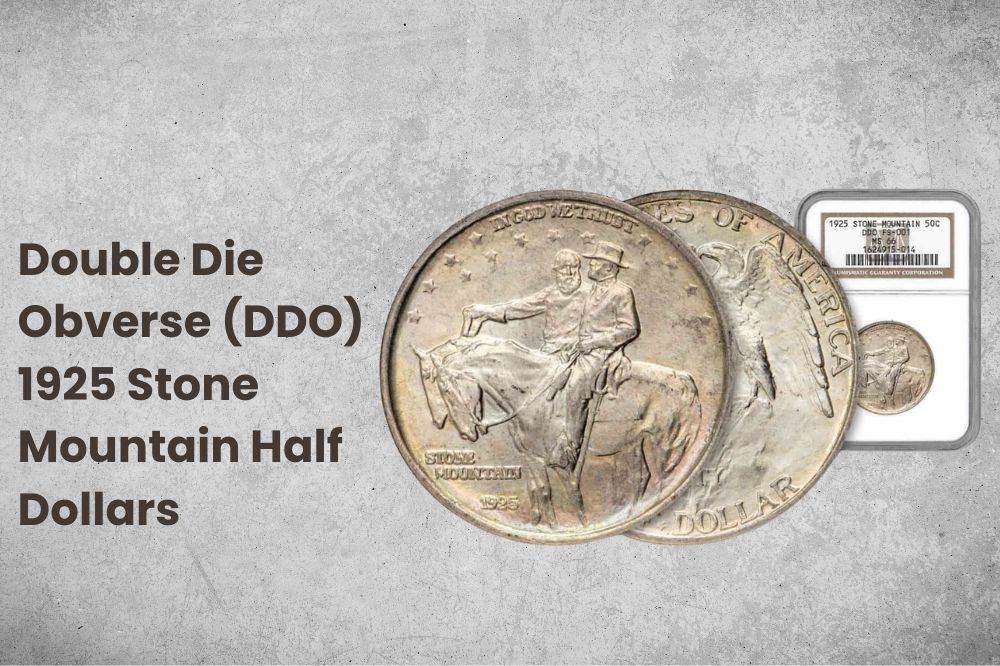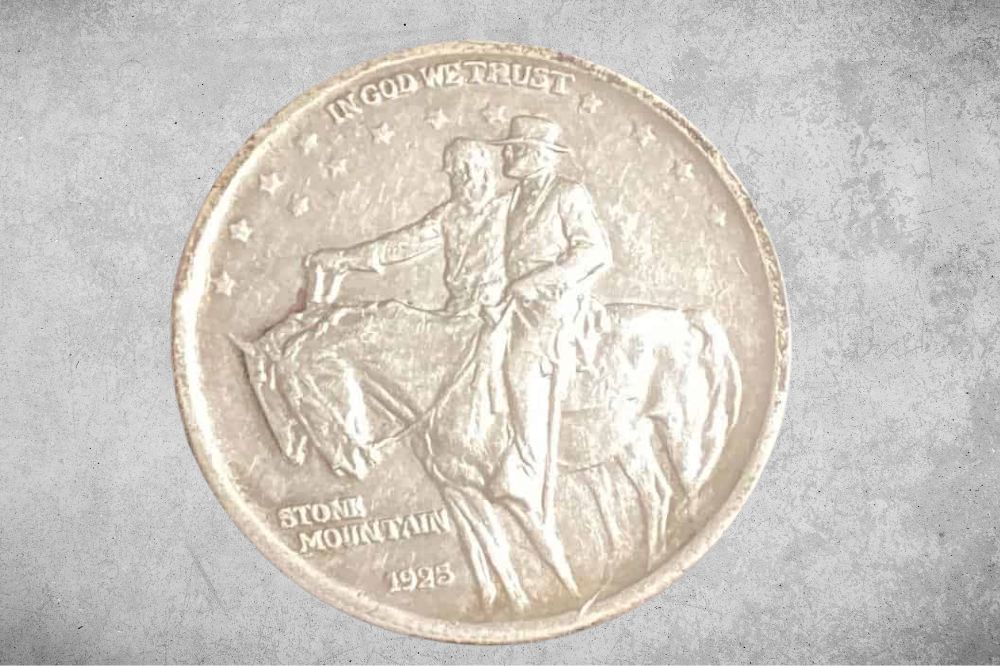The 1925 Stone Mountain half dollar is a controversial coin with many circulating opinions, but it remains a rare and valuable addition to any coin collection. While the coin wasn’t very popular when it was produced, it’s an integral part of American history.
Because it’s a single-year coin, you often see the 1925 Stone Mountain half dollar valued at $32 to $175 or more. When these coins go to auction, they sell for several thousand dollars.
Keep reading to learn more about the basic details of the coin, different variations and errors, and how coin grade affects its value.
1925 Stone Mountain Half Dollar Details
- Category: Commemorative Half Dollar
- Mint: Philadelphia
- Mintage: 2,310,000 (1,000,000 returned to melt)
- Obverse Designer: Gutzon Borglum
- Reverse Designer: Gutzon Borglum
- Composition: 90% Silver; 10% Copper
- Fineness: 0.9
- Weight: 0.44092 oz
- ASW: 0.36169 oz
The 1925 Stone Mountain half dollar features Confederate Generals Robert E. Lee and Thomas Jonathan “Stonewall” Jackson atop horses. The inscription IN GOD WE TRUST reads above their heads, along the top curve of the coin.
The obverse also features 13 stars, the STONE MOUNTAIN location to the left of the horses, and the year 1925 underneath the location (near the horses’ knees). Designer Gutzon Borglum marked the coin with his initials near the horses’ tails.
On the back of the coin, an eagle perches on the rock, ready to take flight. Inscriptions read:
- UNITED STATES OF AMERICA across the top curve
- E PLURIBUS UNUM underneath, to the left of the bird
- MEMORIAL TO THE VALOR OF THE SOLDIER OF THE SOUTH in the middle left of the coin
- LIBERTY near the bottom, with the “TY” raised onto the rock
- HALF DOLLAR along the bottom curve
The reverse also features 35 stars across the background, although the weak strike on many coins renders this collection incomplete. They are located mostly in the left field, although you find them above the eagle’s head and under its wings as well.
1925 Stone Mountain Half Dollar Value Chart |
||||
| Mint Mark | Good | Fine | Extremely Fine | Uncirculated |
| 1925 Stone Mountain Half Dollar Value | $32.00 | $45.00 | $55.00 | $73.00 to $175+ |
1925 Stone Mountain Half Dollar Value and Varieties Guide
There is only one official variety of the 1925 Stone Mountain half dollar, but the attempted distribution of these coins led to several counter-stamped varieties that may attract greater attention or a higher value.
While the production of 5 million coins was authorized, only about 2.3 million were made, and 1 million were returned to melt. This resulted in about 1.3 million in circulation, but the convoluted history of the Stone Mountain story has dampened the coin’s overall value.
1925 Stone Mountain Half Dollar Value

- Type: Commemorative Half Dollar
- Edge: Reeded
- Mint Mark: N/A
- Place of Minting: Philadelphia
- Year of Minting: 1925
- Face Value: $0.50
- $ Price: $32 to $175+
- Quantity Produced: 2,310,000 (1,000,000 returned to melt)
- Designer: Gutzon Borglum
- Mass: 12.5 grams
- Diameter: 30.6 mm
The Philadelphia mint saw the production of 2.31 million 1925 Stone Mountain half dollars, but 1 million were returned to melt when the Stone Mountain Memorial Association (SMMA) wasn’t seeing the sales that they needed.
While these coins aren’t as in-demand as other commemorative pieces, their scarcity still labels them a collectible. Even a Stone Mountain half dollar in “Good” condition sells for about $32, while “Uncirculated” coins often sell for $75 to $175 or greater.
Stack’s holds the current auction record for an MS-65 1925 Stone Mountain half dollar that sold for $37,375 in January 2005.
Counter-stamped 1925 Stone Mountain Half Dollar Values

SMMA distributed the Stone Mountain half dollar across the south and set a sale quota for each state depending on their white population and bank deposits. For example, Florida’s quota was set at 175,000 sales.
This led to the counter-stamping of coins that marked where they were being sold. It’s believed that these stamps were punched by the Association due to their nearly uniform appearance, but this is not confirmed.
Different stamps command different prices on the market, and some see this as another opportunity to collect a set of coins. Some examples include:
- XF Alabama coin marked “ALA. S.L.” selling for $1,680 in April 2021
- AU-50 Oklahoma coin marked “OKLA. G.L” selling for $920 in January 2004
- AU-50 Mississippi coins marked “MISS. G.L” selling for $9,300 in October 2021
As you can see, the value of counter-stamped coins is not necessarily tied to the grade of the coin. You should have any out of standard marks verified by a professional.
1925 Stone Mountain Half Dollar History
The 1925 Stone Mountain half dollar was created to raise money for the Stone Mountain Memorial, a project which spanned several decades and is now the largest Confederate monument in the world.
At the start of the 20th century, the idea for carving a large sculpture in memory of Robert E. Lee was concocted. The location, Stone Mountain, had strong ties to Confederate beliefs, and it was a regular encampment location for the Ku Klux Klan (KKK).
The owners of Stone Mountain, the Venable family, agreed to transfer the title for the location with the stipulation that work would be completed within 12 years or it would be returned to them.
Designer Gutzon Borglum planned for a large sculpture of 200 feet by 1,300 feet, and the project would require plenty of funds to complete. In November 1923, the idea to purchase a coin from the government at face value and sell it for a premium was born.
Congress only approved the coin once it was stipulated the coin would honor late President Warren Harding. Borglum designed several plaster models, and 8 were rejected before they settled on the design we see today.
Even after approval, the Philadelphia mint refused to proceed with production. They saw a lack of mention of Harding in the final design, and President Calvin Coolidge had to approve of the design before production would even start.
The first 1,000 Stone Mountain half dollars were struck in January 1925 on the 101st anniversary of Jackson’s birth. The first and second pieces were presented to the President and Secretary of the Treasury, and the rest were placed in numbered envelopes.
During the time of production, SMMA and Borglum developed a strained relationship. He was ultimately fired in February 1925, and this decision had a negative effect on coin sales moving forward.
The coins didn’t sell well in the north, and lobbying by Union Civil War veterans slowed the project more. Even sales in the south were dismal at best, despite the proposed sales quotas, repeated fundraiser attempts, and hiring of professional publicists.
Ultimately, the SMMA sold the coins to companies and sent the remaining coins to the federal reserve for melting. An audit in 1928 revealed that the campaign only contributed $0.27 per dollar to the carving.
The Stone Mountain Memorial project ceased production that year, and the land was returned to the Venable family. It wasn’t until 1958 that the state of Georgia decided to purchase the land, 1963 that a new architect was hired, and 1970 that the memorial was finally dedicated.
1925 Stone Mountain Half Dollar Grading
The 1925 Stone Mountain half dollar is a single year coin, and you can expect many of these coins to be in similar condition. While you need to pursue professional grading through PCGS or NGC if you intend to sell your coin, you can perform a preliminary assessment of any coin you come across.
These general grades will not bear weight when determining the actual value of the coin, but they provide a better understanding of coin condition. The difference between a “Good” coin and an “Uncirculated” one are quite obvious, but keep in mind that these grades are much left to interpret.
Good
When the 1925 Stone Mountain half dollar drops to a “Good” grade, it loses a significant amount of detail. High points like Lee’s hand, his left leg, his holster, and the bridle near his holster have flattened.
Details like the folds of Lee’s coat, his hat, and feathering on the eagle are smooth. The “TY” on the back is worn down significantly, and the reverse is often missing a few of its 35 stars.
These coins wear their age with pride.
Fine
Nineteen twenty-five Stone Mountain half dollars in “Fine” condition still hold major details, but this is where you see high points and minor details start to wear down. Lee’s gloved hand and left leg are often the first to bear signs of wear, and the lines of his coat and hat have worn down slightly.
On the reverse, the head and top of the eagle’s wings have lost a certain degree of detail. The breast also bears marks, but the legs that are lower in relief may not be affected yet.
The “TY” in LIBERTY is worn at this point, but not so much that you cannot discern the word.
Extremely Fine
An “Extremely Fine” coin is still well preserved, but there are a few marks that prohibit a higher grade. These 1925 Stone Mountain half dollars retain original details such as the lines of the bridle, Lee’s holster, and the folds of Lee’s coat.
High points like the breast of the eagle or the inscriptions on the reverse often show minor signs of wear, often scratches or a slight dulling of the finish. All 35 stars may or may not be present, but those that are bear few marks.
Uncirculated
An uncirculated 1925 Stone Mountain half dollar should appear as if it only just rolled off the press. The coin retains its original luster, and even minor details are well preserved.
Coins that are presumed “Uncirculated” do not bear marks on high points, particularly Lee’s gloved hand, his left leg, or the bridle where it crosses his holster on the obverse. The reverse details may bear marks before the front, particularly on the eagle’s breast, head, and the top of its wings.
List of 1925 Stone Mountain Half Dollar Errors
The 1925 Stone Mountain half dollar is not particularly well struck, and there are several issues that revolve around that weak hit. Errors like missing stars on the back because of this aren’t worth anything extra, but the double die error may command a premium.
Regardless of which error you come across, it must be verified along with the professional grade of the coin to merit any gain in value. While errors add onto the value of the coin, they do not matter nearly as much as the grade.
Double Die Obverse (DDO) 1925 Stone Mountain Half Dollars

A double die obverse is common on the 1925 Stone Mountain half dollar. This issue occurs due to the die shifting between strikes by the obverse hub, causing the second strike to land in a different spot.
This doubling is most obvious around Little Sorrel’s head or the date. You may see a faint, second outline of the horse’s profile (usually in front of the face), or the numbers may have a shadow.
Other signs of doubling have occurred, but these are the most commonly seen. The DDO 1925 Stone Mountain half dollars have sold for $150 at MS-63, $275 at MS-65, and $1,250 at MS-67.
1925 Stone Mountain Half Dollar FAQs
How Much Is the 1925 Stone Mountain 50-cent Piece Worth?
The 1925 Stone Mountain 50-cent piece is worth $32 to $73, but well-preserved or otherwise rare versions of the coin sell for much more. Many auctions have seen this hard-to-find coin sell for several thousand dollars.
How Many 1925 Stone Mountain Half Dollars Were Minted?
While the project approved the production of 5 million 1925 Stone Mountain half dollars, only 2,310,000 were minted. Because the coins sold so poorly at the time, roughly 1 million were returned to melt.
Where Is the Mint Mark on a 1925 Stone Mountain Half Dollar?
There is no mint mark on the 1925 Stone Mountain half dollar. These are commemorative coins that were produced at the Philadelphia Mint, which did not mark its coins at this point in history.
Who Is on the 1925 Stone Mountain Half Dollar?
The 1925 Stone Mountain half dollar features General Robert E. Lee and General Thomas Jonathan “Stonewall” Jackson, two leaders of the Confederacy during the United States Civil War.
